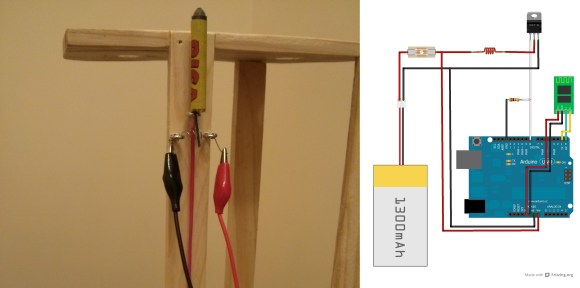
With Canada day and Independence day fast approaching, some makers are looking towards setting up their own fireworks to shoot off in celebration – sure you could use a match or lighter… or you could crack out your trusty Arduino and a cellphone! (translated)
To ignite the fuse, [Oscar] is using a short length of Nichrome wire which is controlled via a Mosfet by the Arduino. To control the Arduino he’s using ArduDroid with a Bluetooth module. The app lets you trigger the various digital and analog outputs, and send and receive data.
Stick around to see a few different demonstration videos of the circuit, testing, and launching some little bottle rockets!
Alternatively, if you need more fireworks you can build a much larger (wired) setup that makes use of resistors burning out to light the fuses.
And as always, make sure you’re launching fireworks where it is legal – many cities have various laws that may change when there is a holiday weekend. Always check first!














IEDuino!
You want IEDs? Because that’s how you get IEDs…
Oh pshaw. Model Rocketry enthusiasts have been doing this with discreet circuits for decades… beyond opening up the triggering to remote access, there’s no real difference (other than the cost of an Arduino board, a Bluetooth module, and a cellphone vs the cost of an enclosure, a couple toggle switches and indicator lamps, and some wire). Which is to say, that what costs a couple hundred bucks here (yes, the cellphone costs money) can just as easily be done for under twenty bucks, and has been for many years.
I fail to see the IED connection.
Welcome to NSA watchlists arduino owners.
You know that everyone is already on them, right?
Almost nothing you do via phone, email or web-surfing escapes being recorded, compressed and stored permanently. Every smart phone grabs pictures and location data all the time. They know what the inside of every house, business and apartment looks like. They know who all your friends are, where you go every day, and what you buy. The data doesn’t go away. It’s never going away, ever. Game over.
And it’s not even a conspiracy, it’s just simple engineering and cheap storage media.
I think it’s pretty cool, actually, but I’m with GWB on the whole constitution thing.
It was all just for show, anyway.
I mean: say what you will about the NSA –
It’s the only branch of government that actually listens!
No one ever imagined that the federal government would dare harness the powers that were formerly held only by Santa Claus… The big guy’s gonna be po’d when he finds out!
Santa was just an early adopter. :)
Or source of inspiration.
Ofcourse wood is the best material to build an installation where fire and heat are available.
But serious: nice hack!
I guess you’ve never seen what professional people use for their racks (hint: it’s wood).
At least it does not form shards and schrapnells :)
And if you’re in California you’re only allowed to buy snakes and sparklers.
Safety note from your friendly neighborhood pyrotech: if you plan on building any kind of firing circuit for your 4th or Canada Day, please add a toggle switch of some kind to arm the circuit prior to firing. Noone likes an accidental discharge, and it’s illegal in most jurisdictions to not do so.
THIS. It’s common sense and good practice (again, the model rocketry community has been doing this for a very long time… they’re a great resource!).
If you ever want to source cheap nichrome wire, buy a hair dryer from good will and gut it.
Resistance wire that has been really hot over a long period or many cycles is usually very brittle.
You could just buy cheap wire on ebay.
I tried to make a light bulb in second grade after reading about Edison. Got away with a nasty burn and a very large residue from the smoke ball around the outlet. It turns out that without a vacuum, a small bit of copper wire inserted into a wall outlet becomes a very brief introduction to plasma. Of course, I then tried the same experiment using a baby food jar for a bulb, but got more or less the same result. Never one to give up, I tried a thicker piece of wire. It certainly glowed, but that was the day I learned about fuses in the basement and encountered my first parental criticism of scientific method.
It cured me of all interest in electronics, until I watched a guy teaching backwoods survival on TV use steel wool to complete a circuit between a couple of regular batteries. We had those things. It worked very well, and you could vary the amount of steel wool so that it glowed rather than burst into flames. I continued experimenting in secret.
I slowly recreated about the first 40 years of 19th century electrical experimenting, eventually working my way up to building arc lights by swiping the carbon rods from old batteries. 1950’s vintage O gauge model train transformers powered many cool experiments that year, including a very poorly constructed dc motor that shot sparks everywhere and needed a push now and then to keep turning. And knife switches – ah, Doctor Frankenstein himself never experienced the joy of a small boy with a couple of DPDT knife switches and a fresh 12v battery with screw on terminals. The world was mine for the taking!
TLDR; steel wool and a 9v battery can amuse a kid for hours.
I had some similar experiences.
Yes, my first knife switch was going to be the one I threw to operate wonders…and it was!
Here is another project, also controlled by bluetooth via an Android App.
https://code.google.com/p/firework-igniter/
Thanks for that link Corey, this has massive potential for small scale LARP gaming and using pyrotechnics.
Could also see these being useful in remote areas to trigger flares or distress beacons for emergencies.